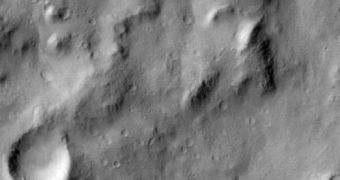A multi-band camera aboard the the NASA Mars Odyssey orbiter recently turned 10 in Martian orbit. The instrument began scientific operations around the Red Planet on February 19, 2002, and has been producing invaluable science ever since.
The Thermal Emission Imaging System (THEMIS) can snap photos in both visible and infrared wavelengths, by combining a five-wavelength visual imaging system with a nine-wavelength infrared imaging system.
This approach enables investigators to determine a large number of the physical properties of rocks and soils in a particular area. This is done by photographing the target region in infrared, both during the day and during the night, and comparing those images.
THEMIS is excellently-suited for this objective. During its decade of operations, it managed to collect more than 500,000 images in the two regions of the electromagnetic spectrum. The data it produces are still in use today, for a variety of applications.
The camera assembly was designed by researcher Philip Christensen, who is based at the Arizona State University (ASU), in Tempe. The expert is also the principal investigator for the camera instrument. Over the course of its mission, Mars Odyssey orbited Mars more than 45,000 times.
During this time, the camera made a great contribution to selecting the landing site for the Mars Exploration Rover (MER) Opportunity. It was also involved in the study that led to the discovery of carbon dioxide gas jets emanating from the Martian south pole during the spring.
By piecing together vast numbers of THEMIS images, scientists were able to create the most detailed global image of Mars available today. The instrument also confirmed the existence of what was once a lake in the Aram Chaos crater.
THEMIS contributes extensively to bettering our understanding of the Red Planet. It monitors the activity of dust in the atmosphere, images chloride salt deposits, maps the surface, and is sometimes responsible for finding good landing sites for other missions.
“THEMIS has proven itself a workhorse. It's especially gratifying to me to see the range of discoveries that have been made using this instrument. Both Odyssey and THEMIS are in excellent health and we look forward to years more science with them,” Christensen said.
Mars Odyssey was built by Denver-based Lockheed Martin Space Systems, and is operated by the Jet Propulsion Laboratory (JPL), in Pasadena, California, for the NASA Science Mission Directorate, in Washington DC.

 14 DAY TRIAL //
14 DAY TRIAL //